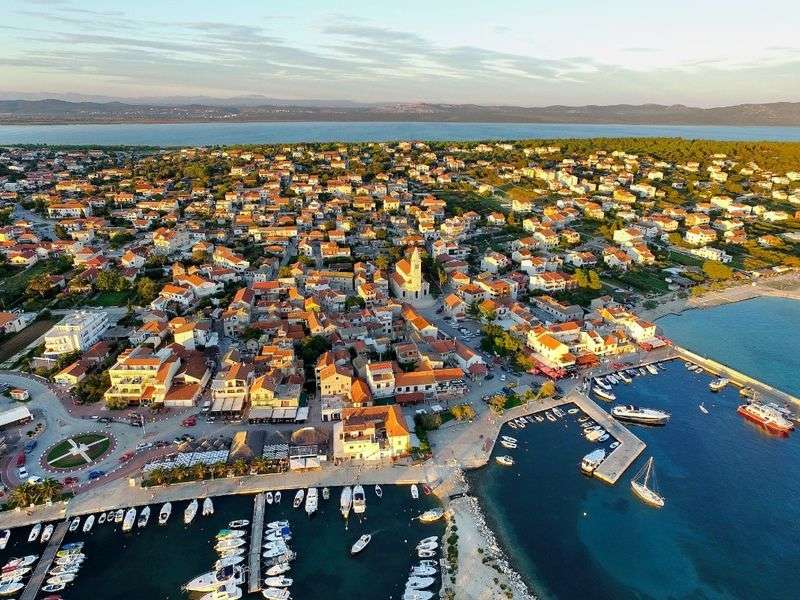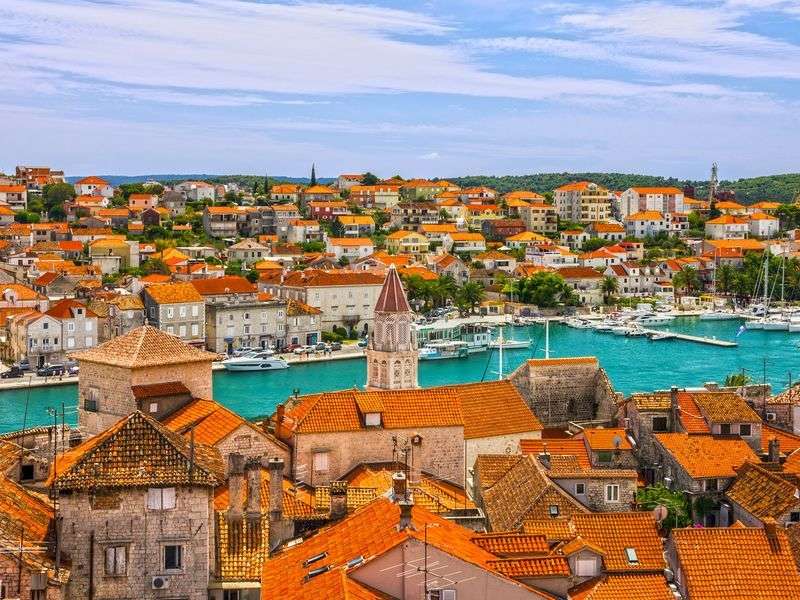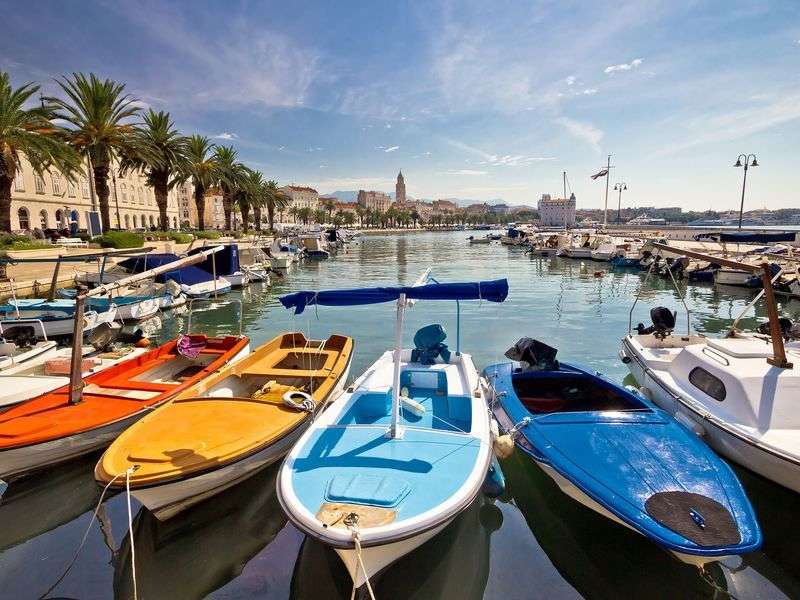Roman ruins, spectacular beaches, old fishermen’s ports, medieval and renaissance architectural monuments and untouched islands. This is Central Dalmatia, where the experience of sailing combines with travels to the past. The coastal landscape is outstanding: the Dinaric Mountains between Dalmatia and Bosnia-Hercegovina with its 1500 metres height makes it adventurous.
This article summarizes the following:
- Kastel Gomilica is the favourite starting point for Dalmatian boat tours
- Towns in Kastel Gomilica vicinity
- What to do in Kastel Gomilica: Tours around Kastel Gomilica
- Things to do in Kastel Gomilicia: Programs that you should not miss
Kastel Gomilica is the favourite starting point for Dalmatian boat tours
Kastel Gomilica is a 17 km long part of the Kastelans bay between Trogir and Split. There used to be seven separate settlements around the seven castles, which today are completely united. Of the 7 forts, Gomilica is the most impressive. It was once the property of the split female monastery. On the island of Gomilica 25 stone buildings were built-in the first half of the 16th century, which preserved in excellent condition. Originally, the settlement was established as a defence fort. The island was connected to the mainland by a small, mobile wooden bridge. In the north-western part of the island, the coast is 25 meters long and the sea is 3 meters deep.
Fort in the city
Kastel Gomilica is the most beautifully preserved fort in the bay. In fact, it was built on an island, a tiny city surrounded by a stone wall. A ten-hole stone bridge leads to the wide gate bastion. There are apartments in the fort, but you should walk through the narrow alleys to get the atmosphere of this place. One of the oldest churches in the area is the Dajman church. Some parts of HBO’s Game of Thrones were filmed in this fort.
Marina Kastela can accommodate more than four hundred yachts and it is one of the largest charter bases in the area. It is one of the favourite starting points for boat trips in Central and Southern Dalmatia. Its facilities are cultured, there are enough parking space and washbasins. Within a few minutes, you can reach the Getro department store, it is the ideal place for big shopping before departure. Gomilica Castle is a 10-minute walk from the harbour, it is worth visiting before departure.
Kastel Bay
Kastel Stafilic’ fort was built-in the early 16th century. Its speciality is the Nehaj Tower, which stands on land, but when the tide comes it gets fully surrounded by the sea. To get into Kastel Stari’s fortress you have to cross a mobile bridge. The old fort was burnt down in the 15th century and the new one was rebuilt-in Renaissance style. The park next to the Palace Hotel has an area of 35, 000 square meters. In Kastel Lukisic on the Balovan Rock, there is a Renaissance palace with two watchtowers. The town museum can be seen in the towers.
Kastel Vitturi’s impressive bastion tower has been beautifully restored. There is a bridge leading to the castle in which you can visit a small museum. In the older buildings of Kastel Sucurac, we can find Roman stones. The remnants of the ancient ruin, Salone, were used as surface stone quarries by the builders. This fortress is the oldest in the Gulf. A hiking trail starts at the fort, which leads up to the 700-meter-high St. Luke Church.
Towns in Kastel Gomilica vicinity
Kastel Novi
The house around the castle that was built-in 1512 with its beautiful windows and balconies are an architectural rarity. Its ancient stone walls follow the fragmentation of the underlying rocks. Between 16th century chapels and churches, it is worth to rest your eyes on the unplastered, enclosed shutters and the market. Genuinely evokes the atmosphere of the beginning of the last century. To enter you have to go through the suspension bridge. In the fortress, you can see clerical clothes and silver exhibition. The church of St. John the Baptist was built-in Baroque style in 1723, is also noteworthy. On the main square of the Cipico Castle fruit, vegetables and fishes are sold.
Solin
The sights of Solin are the Roman ruins of the Salone. It is one of the largest ruin areas in the world. In the Archeological Museum, you can see the smallest finds of the excavations. The multi-kilometre long, monumental waterway from Solin to Split was renewed in 1880. It used to lead the waters of the Jadro stream into the imperial palace of the Diocletianian.
Split
In Split, the sun shines for 7 hours a day on average, and in the summer it reaches twelve. On the beach, you can admire huge cacti, palms and other tropical plants. The city has its own airport, railroad mainline and a huge, well-equipped harbour. The town on the peninsula is protected by high mountains, from the mainland by Koznjak and Mosor, and from the sea by the Marjan Mountain.
Split is the second-largest city in Croatia. Its central location, sights, cultural values and the great climate make it an attractive destination. It is a true southern city, which is under UNESCO protection. Downtown, near to the port, there is a unique historical monument: the former Roman Emperor Diocletian’s Palace. Those who are arriving by boat can easily find it since the harbour is in the same bay in which the palace is hidden. The palace itself is the centre of the city, where Roman Colonnade, Egyptian Sphinx, early medieval church and medieval houses can be seen next to each other, and often built-into one another. There are several museums in the city. Read about what to do in Split.
Trogir
Due to the bridge connecting Trogir with the island of Ciovo, it can be approached only from the west. There are only a few towns in the Croatian Adriatic, where there are so many sights and monuments in such a small area as Trogir. In this city built on the island, it feels like the time had stopped. You can walk between 13-15 century buildings. The old town which guards its image from five hundred years ago was declared a UNESCO World Heritage Site. Most of the attractions are centred around the main square of the Old Town, and the II John Paull square.
Its main attractions include the 15th-century Gothic Cipiko Palace, Sveti Lovro, one of the most beautiful Romanesque cathedrals in Dalmatia, the Town Hall built on the turn of the 13-14th century, the Lucic Palace, the Dominican Monastery and the Camerlengo Fortress. Read about what to do in Trogir.
What to do in Kastel Gomilica: Tours around Kastel Gomilica
The Bay of Kastela has a long beach, yet the area is more suitable for hiking than swimming. From the rocky shore, there is a nice view of the at the white houses foothills of the friendly slopes, hiding between palms, including slender church towers. There are well-growing olive groves, vineyards and fig trees, on the slopes of the mountains stretch behind the shore. Mosor is 780 meters and Kozjak is 1340 meters high.
On Kozjak mountain there is a Biblical Garden, which is decorated with plants and statues mentioned in the Bible. On the slopes of the mountain, the native grape variety, the Kaštelanski crijenak grows. You can see the famous, more than 1, 500 years of a huge olive tree above Kastela Stafilic. It has 100 meters of roots, the log’s perimeter is 6 meters, the diameter of the foliage is 22 meters, and the tree height is 10 meters. In 1990 it was declared a natural monument. At Kastel Lukisic there is a natural monument, the Vitturi Park. There is also a botanical garden with over 1400 native and exotic plants and over 45 olive trees.
Things to do in Split
The Marjan Hill, which is hiking, cultural and entertainment centre, rises on the western tip of the peninsula of Split. Due to its shady trees, its flowery promenades and the view from the hilltop, it is worth visiting during the day and night. Gentle rising stairs lead up to the mountain. Along the way up there is also the Natural History Museum and a zoo. There is a deepwater aquarium on the other side of the park, in the distant corner of the beach. On the mountain, there is also an archaeological museum and a 17th-century palace. On the outskirts of Split, you can find the church of Sveti Triniti, which is one of the best-preserved ancient Christian basilicas in Croatia.
Things to do in Kastel Gomilicia: Programs that you should not miss
The Kastela Cultural Festival is held in the bay from 1 July to 31 August, which includes exhibitions, performances, concerts, traditional performances and sports events. Kastel Kambelova is hosting the Evening of Dalmatian Songs. In Split, Saint Domnius is celebrated on May 7, in May, there is the Flower Show, and at the end of June, a 4-day pop music festival is held. The summer festival is between mid-July and mid-August, the jazz festival begins in late July, and in the middle of August, the Creative Disaster Festival, and from June to September, there are continuous evening performances in the old town.
From mid-June to mid-August, Trogir hosts a summer music festival with classical and folk music concerts. Gomilica’s well-equipped harbour is a convenient starting point for exploring the islands of the region or for starting a bigger Adriatic tour.
The Bay of Kastela offers a variety of activities. Pleasant walking in historic old towns, great restaurants with Dalmatian cuisine, water sports and excursions. Kastel Gomilica is one of the best choices in Central Dalmatia. Read more if you plan sailing in Kastel Gomilica or rent a boat in Kastel Gomilica.




